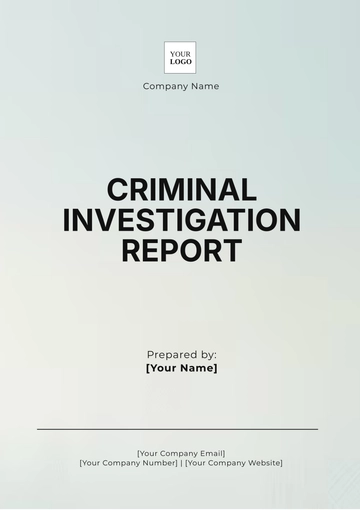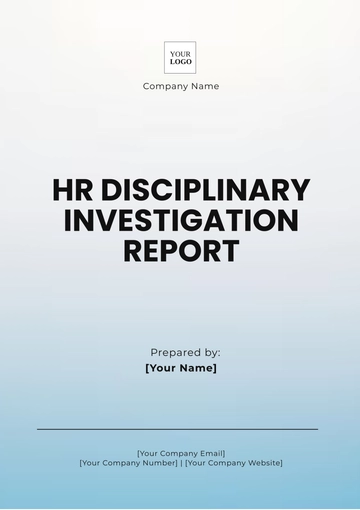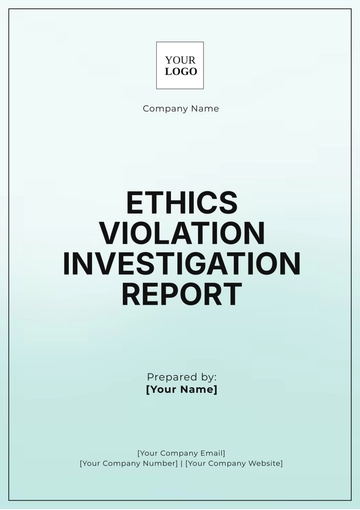Free Online Harassment Investigation Report

Prepared By: [Your Name]
Company: [Your Company Name]
Date: March 2, 2050
I. Introduction
The purpose of this report is to present the findings and analysis of an investigation into online harassment incidents. This investigation was conducted over six months and aimed to uncover the extent, nature, and impact of online harassment on victims. The collected evidence and testimony have been carefully reviewed to provide comprehensive insights and recommendations to address and mitigate this issue.
II. Background and Context
A. Definition of Online Harassment
Online harassment refers to any form of malicious behavior conducted through digital platforms. This can include verbal abuse, intimidation, threats, stalking, and spreading false information. The anonymity and reach provided by the internet often exacerbate the impact of such harassment on victims.
B. Significance of the Issue
Online harassment has grown significantly with the proliferation of digital communication channels. It poses serious threats to the mental health, safety, and well-being of individuals. Understanding its dynamics is crucial for formulating effective strategies to counteract the abuse and support the victims adequately.
III. Methodology
A. Data Collection
The investigation involved multiple data collection methods, including:
Online surveys distributed to victims of online harassment
Interviews with experts in cyberpsychology and law enforcement personnel
Analysis of online platforms and social media threads
B. Data Analysis
The collected data was analyzed to identify patterns and trends in online harassment. Statistical tools were employed to quantify the prevalence and severity of incidents, while qualitative analysis provided context and a detailed understanding of individual experiences.
IV. Findings
A. Types of Online Harassment
The investigation identified several types of online harassment that victims commonly face:
Type | Description |
|---|---|
Cyberstalking | Persistent tracking and monitoring of an individual's online activity. |
Bullying | Repeated verbal abuse, insults, and derogatory comments aimed at embarrassing or intimidating the victim. |
Doxxing | Public release of private information without consent, often to incite further harassment. |
Impersonation | Creation of fake profiles and accounts to deceive others and damage the victim's reputation. |
B. Demographics of Victims
The profile of victims was analyzed to understand how online harassment affects different demographic groups. The findings indicated that:
Women and minorities are disproportionately targeted.
Younger individuals (ages 18-29) experience higher rates of harassment.
Individuals identifying with the LGBTQ+ community report more severe incidents.
V. Impact of Online Harassment
A. Psychological Effects
Victims of online harassment often experience significant psychological distress, which can manifest as:
Anxiety and depression
Reduced self-esteem and confidence
Fear and paranoia
B. Social Consequences
The social implications for victims include isolation, withdrawal from online communities, and strained relationships with friends and family.
VI. Recommendations
A. Platform Regulations
It is recommended that online platforms implement stricter policies to combat harassment. This includes:
Enhanced reporting and moderation tools
Proactive monitoring for abusive behavior
Swift and transparent disciplinary actions against offenders
B. Support Systems
Victims should have access to robust support systems, including:
Counseling and mental health services
Legal assistance and advocacy
Community support groups
C. Educational Initiatives
Raising awareness and educating the public about the dangers of online harassment can help mitigate its impact. Recommended measures include:
Workshops and seminars on digital safety
Incorporating online etiquette and safety into school curricula
Campaigns to promote respectful online behavior
VII. Conclusion
This report highlights the severe issue of online harassment and its far-reaching impact on victims. By understanding the types, demographics, and effects of harassment, and implementing the recommended measures, stakeholders can work towards creating a safer and more respectful online environment for all users.
- 100% Customizable, free editor
- Access 1 Million+ Templates, photo’s & graphics
- Download or share as a template
- Click and replace photos, graphics, text, backgrounds
- Resize, crop, AI write & more
- Access advanced editor
Address online harassment effectively with the Online Harassment Investigation Report Template from Template.net. This editable and customizable template provides a structured format for documenting incidents, evidence, and witness statements. Designed for clarity and ease of use, it allows you to tailor the content to meet specific organizational requirements. Create professional reports that support thorough investigations and foster a safer online environment with this essential reporting tool.
You may also like
- Sales Report
- Daily Report
- Project Report
- Business Report
- Weekly Report
- Incident Report
- Annual Report
- Report Layout
- Report Design
- Progress Report
- Marketing Report
- Company Report
- Monthly Report
- Audit Report
- Status Report
- School Report
- Reports Hr
- Management Report
- Project Status Report
- Handover Report
- Health And Safety Report
- Restaurant Report
- Construction Report
- Research Report
- Evaluation Report
- Investigation Report
- Employee Report
- Advertising Report
- Weekly Status Report
- Project Management Report
- Finance Report
- Service Report
- Technical Report
- Meeting Report
- Quarterly Report
- Inspection Report
- Medical Report
- Test Report
- Summary Report
- Inventory Report
- Valuation Report
- Operations Report
- Payroll Report
- Training Report
- Job Report
- Case Report
- Performance Report
- Board Report
- Internal Audit Report
- Student Report
- Monthly Management Report
- Small Business Report
- Accident Report
- Call Center Report
- Activity Report
- IT and Software Report
- Internship Report
- Visit Report
- Product Report
- Book Report
- Property Report
- Recruitment Report
- University Report
- Event Report
- SEO Report
- Conference Report
- Narrative Report
- Nursing Home Report
- Preschool Report
- Call Report
- Customer Report
- Employee Incident Report
- Accomplishment Report
- Social Media Report
- Work From Home Report
- Security Report
- Damage Report
- Quality Report
- Internal Report
- Nurse Report
- Real Estate Report
- Hotel Report
- Equipment Report
- Credit Report
- Field Report
- Non Profit Report
- Maintenance Report
- News Report
- Survey Report
- Executive Report
- Law Firm Report
- Advertising Agency Report
- Interior Design Report
- Travel Agency Report
- Stock Report
- Salon Report
- Bug Report
- Workplace Report
- Action Report
- Investor Report
- Cleaning Services Report
- Consulting Report
- Freelancer Report
- Site Visit Report
- Trip Report
- Classroom Observation Report
- Vehicle Report
- Final Report
- Software Report





























